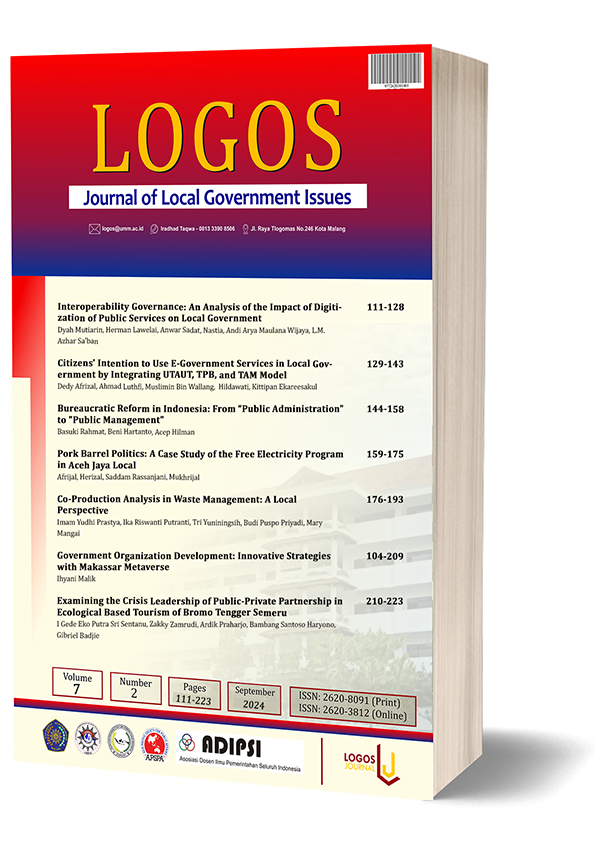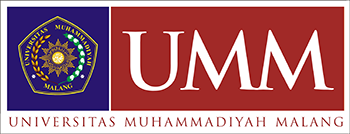Interoperability Governance: An Analysis of the Impact of Digitization of Public Services on Local Government
DOI:
https://doi.org/10.22219/logos.v7i2.30388Keywords:
Public Policy, Coordination, Digitalization, Public Service, Logal GovernmentAbstract
The study highlights the significance of understanding the impact of digitalization on public services in local government organizations, particularly about coordination strategy and digitalization policy. The rapid advancements in information technology have transformed the delivery and acquisition of public services, necessitating a comprehensive understanding of the factors influencing the efficiency of digital services. A quantitative approach was used, with Smart-PLS 3.0 analysis involving respondents from South Buton Regency local government organizations. Data collection was conducted through a direct survey in the field. The results showed a strong relationship between coordination, strategy, and digitalization policy, with a significant relationship between these factors and the effectiveness of digital services. However, no significant relationship between digitalization policy and digital service effectiveness was found. The results of this study provide valuable insights into the dynamics of interoperability governance and the nuanced relationships between coordination, strategy, digitization policy, and digital service effectiveness in local government organizations. Despite the significant influence of coordination and strategy, the role of digitalization policy on digital service effectiveness suggests the need for further evaluation or a change in policy approach. Limitations of this study include the small sample size and focus on one geographical area, so caution is needed in generalizing the findings. Nevertheless, this study contributes significantly to understanding the implementation of digitization in public services, with practical implications for policy development and management practices.
Downloads
References
Abidin, Z., Didi, L., & Yuharsi. (2021). Implementasi Kebijakan E-Procurement di Kabupaten Buton Selatan. Sawala : Jurnal Administrasi Negara, 9(2), 155–167. https://doi.org/10.30656/sawala.v9i2.3421
Almgren, R., & Skobelev, D. (2020). Evolution of technology and technology governance. Journal of Open Innovation: Technology, Market, and Complexity, 6(2), 22. https://doi.org/10.3390/JOITMC6020022
Arduini, D., Denni, M., Lucchese, M., Nurra, A., & Zanfei, A. (2013). The role of technology, organization and contextual factors in the development of e-Government services: An empirical analysis on Italian Local Public Administrations. Structural Change and Economic Dynamics, 27, 177–189. https://doi.org/10.1016/j.strueco.2013.06.007
Chwiłkowska-Kubala, A., Cyfert, S., Malewska, K., Mierzejewska, K., Szumowski, W., & Prause, G. (2023). What drives organizational agility in energy sector companies? The role of strategic CSR initiatives and the dimensions of proactive CSR. Sustainable Futures, 6, 100133. https://doi.org/10.1016/j.sftr.2023.100133
Cordella, A., & Tempini, N. (2015). E-government and organizational change: Reappraising the role of ICT and bureaucracy in public service delivery. Government Information Quarterly, 32(3), 279–286. https://doi.org/10.1016/j.giq.2015.03.005
Dănăiaţă, D., Margea, C., Hurbean, L., & Artene, A. S. (2014). Electronic Services for Business Environment. Procedia - Social and Behavioral Sciences, 124, 351–360. https://doi.org/10.1016/j.sbspro.2014.02.496
Deng, X., Chen, T., & Pan, D. (2008). Organizational coordination theory and its application in virtual enterprise. IFIP Advances in Information and Communication Technology, 254 VOLUME, 311–316. https://doi.org/10.1007/978-0-387-75902-9_32
Dzator, J., Acheampong, A. O., Appiah-Otoo, I., & Dzator, M. (2023). Leveraging digital technology for development: Does ICT contribute to poverty reduction? Telecommunications Policy, 47(4), 102524. https://doi.org/10.1016/j.telpol.2023.102524
Fahmi, F. Z., & Mendrofa, M. J. S. (2023). Rural transformation and the development of information and communication technologies: Evidence from Indonesia. Technology in Society, 75, 102349. https://doi.org/10.1016/j.techsoc.2023.102349
Fan, B., & Pan, T. (2023). Does information technology–organizational resource interaction affect E-government performance? Moderating roles of environmental uncertainty. Government Information Quarterly, 40(3), 101830. https://doi.org/10.1016/j.giq.2023.101830
Gasco-Hernandez, M., Nasi, G., Cucciniello, M., & Hiedemann, A. M. (2022). The role of organizational capacity to foster digital transformation in local governments: The case of three European smart cities. Urban Governance, 2(2), 236–246. https://doi.org/10.1016/j.ugj.2022.09.005
Geebren, A., Jabbar, A., & Luo, M. (2021). Examining the role of consumer satisfaction within mobile eco-systems: Evidence from mobile banking services. Computers in Human Behavior, 114, 106584. https://doi.org/10.1016/j.chb.2020.106584
Ghobadian, A., Speller, S., & Jones, M. (1994). Service Quality Concepts and Models. International Journal of Quality & Reliability Management, 11(9), 43–66. https://doi.org/10.1108/02656719410074297
Gómez-Carmona, O., Buján-Carballal, D., Casado-Mansilla, D., López-de-Ipiña, D., Cano-Benito, J., Cimmino, A., Poveda-Villalón, M., García-Castro, R., Almela-Miralles, J., Apostolidis, D., Drosou, A., Tzovaras, D., Wagner, M., Guadalupe-Rodriguez, M., Salinas, D., Esteller, D., Riera-Rovira, M., González, A., Clavijo-Ágreda, J., … Bujalkova, N. (2023). Mind the gap: The AURORAL ecosystem for the digital transformation of smart communities and rural areas. Technology in Society, 74, 102304. https://doi.org/10.1016/j.techsoc.2023.102304
Gottschalk, P. (2009). Maturity levels for interoperability in digital government. Government Information Quarterly, 26(1), 75–81. https://doi.org/10.1016/j.giq.2008.03.003
Hatuka, T., & Zur, H. (2020). From smart cities to smart social urbanism: A framework for shaping the socio-technological ecosystems in cities. Telematics and Informatics, 55. https://doi.org/10.1016/j.tele.2020.101430
Ho, C. Y., Narins, T. P., & Sung, W. (2023). Developing information and communication technology with the belt and road initiative and the digital silk road. Telecommunications Policy, 47(10), 102672. https://doi.org/10.1016/j.telpol.2023.102672
Ho, D. H., Lee, Y., Nagireddy, S., Thota, C., Never, B., & Wang, Y. (2022). OpenComm: Open community platform for data integration and privacy preserving for 311 calls. Sustainable Cities and Society, 83, 103858. https://doi.org/10.1016/j.scs.2022.103858
Hu, G., Shi, J., Pan, W., & Wang, J. (2012). A hierarchical model of e-government service capability: An empirical analysis. Government Information Quarterly, 29(4), 564–572. https://doi.org/10.1016/j.giq.2012.04.007
Irani, Z., Abril, R. M., Weerakkody, V., Omar, A., & Sivarajah, U. (2023). The impact of legacy systems on digital transformation in European public administration: Lesson learned from a multi case analysis. Government Information Quarterly, 40(1), 101784. https://doi.org/10.1016/j.giq.2022.101784
Kalogirou, V., Stasis, A., & Charalabidis, Y. (2022). Assessing and improving the National Interoperability Frameworks of European Union Member States: The case of Greece. Government Information Quarterly, 39(3). https://doi.org/10.1016/j.giq.2022.101716
Karman, K., Deswanto, R., & Ningsih, S. A. (2021). Implementasi E-Government Pada Pemerintah Daerah. Jurnal Studi Ilmu Pemerintahan, 2(2), 43–50. https://doi.org/10.35326/jsip.v2i2.1525
Lawelai, H., Iswanto, I., & Raharja, N. M. (2023). Use of Artificial Intelligence in Public Services: A Bibliometric Analysis and Visualization. TEM Journal, 12(2), 798–807. https://doi.org/10.18421/TEM122-24
Liu, W., Zhou, W., & Lu, L. (2022). An innovative digitization evaluation scheme for Spatio-temporal coordination relationship between multiple knowledge driven rural economic development and agricultural ecological environment—Coupling coordination model analysis based on Guangxi. Journal of Innovation and Knowledge, 7(3), 100208. https://doi.org/10.1016/j.jik.2022.100208
Lopez-Carreiro, I., Monzon, A., Lopez, E., & Lopez-Lambas, M. E. (2020). Urban mobility in the digital era: An exploration of travellers’ expectations of MaaS mobile-technologies. Technology in Society, 63. https://doi.org/10.1016/j.techsoc.2020.101392
Madan, R., & Ashok, M. (2023). AI adoption and diffusion in public administration: A systematic literature review and future research agenda. Government Information Quarterly, 40(1), 101774. https://doi.org/10.1016/j.giq.2022.101774
McCaig, M., Dara, R., & Rezania, D. (2023). Farmer-centric design thinking principles for smart farming technologies. Internet of Things (Netherlands), 23, 100898. https://doi.org/10.1016/j.iot.2023.100898
Mergel, I., Edelmann, N., & Haug, N. (2019). Defining digital transformation: Results from expert interviews. Government Information Quarterly, 36(4), 101385. https://doi.org/10.1016/j.giq.2019.06.002
Mora, L., Gerli, P., Ardito, L., & Messeni Petruzzelli, A. (2023). Smart city governance from an innovation management perspective: Theoretical framing, review of current practices, and future research agenda. Technovation, 123, 102717. https://doi.org/10.1016/j.technovation.2023.102717
Nazarenko, A., Vishnevskiy, K., Meissner, D., & Daim, T. (2022). Applying digital technologies in technology roadmapping to overcome individual biased assessments. Technovation, 110, 102364. https://doi.org/10.1016/j.technovation.2021.102364
Nugraha, D. P., Setiawan, B., Nathan, R. J., & Fekete-Farkas, M. (2022). Fintech Adoption Drivers for Innovation for SMEs in Indonesia. Journal of Open Innovation: Technology, Market, and Complexity, 8(4), 208. https://doi.org/10.3390/joitmc8040208
Panagiotopoulos, P., Protogerou, A., & Caloghirou, Y. (2023). Dynamic capabilities and ICT utilization in public organizations: An Empirical testing in local government. Long Range Planning, 56(1), 102251. https://doi.org/10.1016/j.lrp.2022.102251
Prendiville, A. (2018). Amplifying Relationships through Place and Locality in the Design of Local Government Digital Services. She Ji, 4(1), 47–59. https://doi.org/10.1016/j.sheji.2018.02.007
Reggi, L., & Dawes, S. S. (2022). Creating Open Government Data ecosystems: Network relations among governments, user communities, NGOs and the media. Government Information Quarterly, 39(2), 101675. https://doi.org/10.1016/j.giq.2022.101675
Ringle, C.M., Wende, S., Becker, J.-M. (2015). SmartPLS 3. SmartPLS,. In B¨onningstedt. (Issue Boenningstedt: SmartPLS, p. http://www. smartpls. com). Boenningstedt.
Ristiandy, R. (2020). Bureaucratic Disrupsion and Threats of Unemployment in the Indsutri 4.0 Revolution. Journal of Local Government Issues, 3(1), 86–97. https://doi.org/10.22219/logos.v3i1.10923
Sarkar, S. (2021). Breaking the chain: Governmental frugal innovation in Kerala to combat the COVID-19 pandemic. Government Information Quarterly, 38(1). https://doi.org/10.1016/j.giq.2020.101549
Scupola, A., & Mergel, I. (2022). Co-production in digital transformation of public administration and public value creation: The case of Denmark. Government Information Quarterly, 39(1), 101650. https://doi.org/10.1016/j.giq.2021.101650
Shahaab, A., Khan, I. A., Maude, R., Hewage, C., & Wang, Y. (2023). Public service operational efficiency and blockchain – A case study of Companies House, UK. Government Information Quarterly, 40(1), 101759. https://doi.org/10.1016/j.giq.2022.101759
Shamim, S., Yang, Y., Zia, N. U., & Shah, M. H. (2021). Big data management capabilities in the hospitality sector: Service innovation and customer generated online quality ratings. Computers in Human Behavior, 121, 106777. https://doi.org/10.1016/j.chb.2021.106777
Sharifi, H., & Zarei, B. (2004). An adaptive approach for implementing e-government in I.R. Iran. Journal of Government Information, 30(5–6), 600–619. https://doi.org/10.1016/j.jgi.2004.10.005
Silva, B. N., Khan, M., & Han, K. (2018). Towards sustainable smart cities: A review of trends, architectures, components, and open challenges in smart cities. Sustainable Cities and Society, 38, 697–713. https://doi.org/10.1016/j.scs.2018.01.053
Tao, Z., & Shuliang, Z. (2022). Collaborative innovation relationship in Yangtze River Delta of China: Subjects collaboration and spatial correlation. Technology in Society, 69, 101974. https://doi.org/10.1016/j.techsoc.2022.101974
Thompson, M., & Venters, W. (2021). Platform, or technology project? A spectrum of six strategic ‘plays’ from UK government IT initiatives and their implications for policy. Government Information Quarterly, 38(4), 101628. https://doi.org/10.1016/j.giq.2021.101628
Tong, R., Sui, T., Feng, L., & Lin, L. (2023). The digitization work of cement plant in China. Cement and Concrete Research, 173, 107266. https://doi.org/10.1016/j.cemconres.2023.107266
Trieu, H. D. X., Nguyen, P. Van, Nguyen, T. T. M., Vu, H. T. M., & Tran, K. T. (2023). Information technology capabilities and organizational ambidexterity facilitating organizational resilience and firm performance of SMEs. Asia Pacific Management Review, 28(4), 544–555. https://doi.org/10.1016/j.apmrv.2023.03.004
Turner, M., Kim, J., & Kwon, S. H. (2022). The Political Economy of E-Government Innovation and Success in Korea. Journal of Open Innovation: Technology, Market, and Complexity, 8(3). https://doi.org/10.3390/joitmc8030145
van Holstein, E., Wiesel, I., Bigby, C., & Gleeson, B. (2021). People with intellectual disability and the digitization of services. Geoforum, 119, 133–142. https://doi.org/10.1016/j.geoforum.2020.12.022
Weerakkody, V., Omar, A., El-Haddadeh, R., & Al-Busaidy, M. (2016). Digitally-enabled service transformation in the public sector: The lure of institutional pressure and strategic response towards change. Government Information Quarterly, 33(4), 658–668. https://doi.org/10.1016/j.giq.2016.06.006
Wei, Y. (2022). Reprint of: Regional governments and opportunity entrepreneurship in underdeveloped institutional environments: An entrepreneurial ecosystem perspective. Research Policy, 51(9), 104667. https://doi.org/10.1016/j.respol.2022.104667
Wonglimpiyarat, J., & Yuberk, N. (2005). In support of innovation management and Roger’s Innovation Diffusion theory. Government Information Quarterly, 22(3), 411–422. https://doi.org/10.1016/j.giq.2005.05.005
Wulandari, R. F., & Anshori, Y. T. El. (2012). Optimizing Public Service Through E-Gov Services (the Case of Public Service in South Jakarta Munici Pality). Journal of Government and Politics, 3(2), 369–390. https://doi.org/10.18196/jgp.2012.0021
Yeh, H. (2017). The effects of successful ICT-based smart city services: From citizens’ perspectives. Government Information Quarterly, 34(3), 556–565. https://doi.org/10.1016/j.giq.2017.05.001
Yigitcanlar, T., Li, R. Y. M., Beeramoole, P. B., & Paz, A. (2023). Artificial intelligence in local government services: Public perceptions from Australia and Hong Kong. Government Information Quarterly, 40(3), 101833. https://doi.org/10.1016/j.giq.2023.101833
Zhao, B., Cheng, S., Schiff, K. J., & Kim, Y. (2023). Digital transparency and citizen participation: Evidence from the online crowdsourcing platform of the City of Sacramento. Government Information Quarterly, 40(4), 101868. https://doi.org/10.1016/j.giq.2023.101868
Zou, Q., Mao, Z., Yan, R., Liu, S., & Duan, Z. (2023). Vision and reality of e-government for governance improvement: Evidence from global cross-country panel data. Technological Forecasting and Social Change, 194, 122667. https://doi.org/10.1016/j.techfore.2023.122667
Downloads
Published
How to Cite
Issue
Section
License
Copyright (c) 2024 Dyah Mutiarin, Herman Lawelai, Anwar Sadat, Nastia Nastia, Andi Arya Maulana Wijaya, L.M. Azhar Sa'ban

This work is licensed under a Creative Commons Attribution-ShareAlike 4.0 International License.
Authors who publish with this journal agree to the following terms:
- Authors retain copyright and grant the journal right of first publication with the work simultaneously licensed under a Creative Commons Attribution-ShareAlike 4.0 International License. that allows others to share the work with an acknowledgment of the work's authorship and initial publication in this journal.
- Authors are able to enter into separate, additional contractual arrangements for the non-exclusive distribution of the journal's published version of the work (e.g., post it to an institutional repository or publish it in a book), with an acknowledgment of its initial publication in this journal.
- Authors are permitted and encouraged to post their work online (e.g., in institutional repositories or on their website) prior to and during the submission process, as it can lead to productive exchanges, as well as earlier and greater citation of published work (See The Effect of Open Access).

This work is licensed under a Creative Commons Attribution-ShareAlike 4.0 International License.













